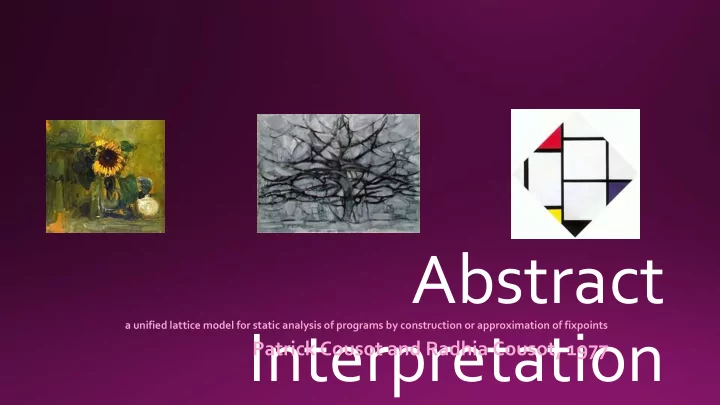

Abstract a unified lattice model for static analysis of programs by construction or approximation of fixpoints Interpretation Patrick Cousot and Radhia Cousot, 1977
Motivation (for static analysis) Say you’ve written code that you really don’t want bugs in… ….like the controls for some rocket boots.
Motivation You want to reason about x t Note: These sketches, and the intuition behind them, are from Patrick Cousot’s website!
Motivation To make sure you’re safe x t
Motivation ….but you can’t analyze code perfectly Halting Problem
Motivation Testing is dangerous… x t
Motivation Luckily you have an ally… S S I I S S Y Y L L A A N N A A
Motivation Better safe than sorry! With the power of… Abstraction!
History – before this paper • Early 70s work in data flow, type systems, etc • As well as mathematical semantics
This paper Uses mathematical semantics to give a grand unified theory of static analysis Trivia: Based on authors’ work in interval analysis Initially a 100 page handwritten manuscript submitted to the 4 th POPL
After this paper • Rich literature on static analysis in just about any domain you want • Further theoretical exploration of AI • Future, more computer-aided design.
Some Definitions • A lattice is a partial order < L, ≤ > such that every two elements have a unique supremum (join) and infimum (meet) • A complete lattice has a unique join and meet for every non-empty subset of L • A semi-lattice only has join (or meet) (from Wikipedia) Order Theory
Abstraction Abstract γ α Concrete
Properties of α, γ? • Abstract γ α Concrete
Examples of Abstractions • Sets of Integers • (unbounded) Intervals • Congruence mod 2 • One value or Sign
Interpretation How do we actually use this? How do we actually use this? Hi I’m a PL Here have this semantics Wow it’s great tnx
In this case • Flowchart language • Context-collecting semantics (cv) • Local Interpretation Int(r,cv) • Global Interpretation G-Int(cv) • cv = G-Int(cv) • Least fixed point • Iterate G-Int(bot) to solve
Abstract Interpretation
Widening • So, we’re done, right? • No! • We could be walking an infinite path Bot LFP • Instead – jump! With over-approximations
Widening
Narrowing • We might jump way too far • Walk it back! • Again, this may be an (infinitely) long walk
Narrowing
Recommend
More recommend